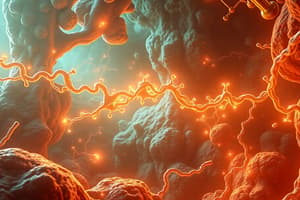Podcast
Questions and Answers
What is the primary role of G6PD in red blood cells?
What is the primary role of G6PD in red blood cells?
- To facilitate iron absorption in the bloodstream.
- To regulate hemoglobin production.
- To produce ATP for energy.
- To detoxify free radicals using reduced glutathione. (correct)
Which factor is NOT a common trigger for hemolysis in individuals with G6PD deficiency?
Which factor is NOT a common trigger for hemolysis in individuals with G6PD deficiency?
- Fava beans consumption.
- Oxidant drugs like chloramphenicol.
- Infections leading to inflammatory responses.
- Uncontrolled diabetes. (correct)
What is the consequence of oxidative damage in RBCs due to G6PD deficiency?
What is the consequence of oxidative damage in RBCs due to G6PD deficiency?
- Development of Heinz bodies. (correct)
- Increase in hematocrit levels.
- Enhanced oxygen transport capacity.
- Formation of atherosclerotic plaques.
Which of the following is a key feature of nitrates and nitrites produced from nitric oxide?
Which of the following is a key feature of nitrates and nitrites produced from nitric oxide?
How does G6PD deficiency provide evolutionary advantages against malaria?
How does G6PD deficiency provide evolutionary advantages against malaria?
Which nonoxidative function is primarily associated with NADPH?
Which nonoxidative function is primarily associated with NADPH?
What is a major consequence of the lack of alternative NADPH sources in RBCs?
What is a major consequence of the lack of alternative NADPH sources in RBCs?
Which process is primarily highlighted by the interaction of macrophages and reactive oxygen species (ROS)?
Which process is primarily highlighted by the interaction of macrophages and reactive oxygen species (ROS)?
What is one of the primary functions of the cytochrome P450 monooxygenase system in the mitochondrial system?
What is one of the primary functions of the cytochrome P450 monooxygenase system in the mitochondrial system?
Which mechanism is involved in the production of reactive oxygen species (ROS) during phagocytosis?
Which mechanism is involved in the production of reactive oxygen species (ROS) during phagocytosis?
How does nitric oxide (NO) lead to vasodilation?
How does nitric oxide (NO) lead to vasodilation?
What role do cytochrome P450 enzymes play in drug metabolism?
What role do cytochrome P450 enzymes play in drug metabolism?
Which type of nitric oxide synthase (NOS) is primarily involved in the immune defense mechanism?
Which type of nitric oxide synthase (NOS) is primarily involved in the immune defense mechanism?
What is a characteristic of the microsomal system of cytochrome P450 enzymes?
What is a characteristic of the microsomal system of cytochrome P450 enzymes?
What is one outcome of NADPH oxidase deficiency?
What is one outcome of NADPH oxidase deficiency?
Which of the following is NOT a function of cytochrome P450 enzymes?
Which of the following is NOT a function of cytochrome P450 enzymes?
Which enzyme is primarily responsible for the dehydrogenation of glucose 6-phosphate during the irreversible oxidative phase of the pentose phosphate pathway?
Which enzyme is primarily responsible for the dehydrogenation of glucose 6-phosphate during the irreversible oxidative phase of the pentose phosphate pathway?
What are the primary products of the irreversible oxidative phase for each glucose 6-phosphate processed?
What are the primary products of the irreversible oxidative phase for each glucose 6-phosphate processed?
During the reversible nonoxidative phase of the pentose phosphate pathway, what are some of the sugar-phosphates that ribulose 5-phosphate can be converted into?
During the reversible nonoxidative phase of the pentose phosphate pathway, what are some of the sugar-phosphates that ribulose 5-phosphate can be converted into?
What is one of the key roles of NADPH in the body?
What is one of the key roles of NADPH in the body?
Why do red blood cells depend solely on the pentose phosphate pathway for NADPH production?
Why do red blood cells depend solely on the pentose phosphate pathway for NADPH production?
Which process describes how NADPH protects cells from oxidative stress?
Which process describes how NADPH protects cells from oxidative stress?
What is the effect of insulin on glucose 6-phosphate dehydrogenase?
What is the effect of insulin on glucose 6-phosphate dehydrogenase?
What role does the Cytochrome P450 monooxygenase system play in metabolism?
What role does the Cytochrome P450 monooxygenase system play in metabolism?
Flashcards
Cytochrome P450 function
Cytochrome P450 function
Hydroxylates substrates (like steroids, drugs, or toxins) using NADPH and molecular oxygen.
Cytochrome P450 location (mitochondrial)
Cytochrome P450 location (mitochondrial)
Found in steroidogenic tissues (like adrenal glands, ovaries, and liver) and involved in steroid hormone, bile acid, and vitamin D synthesis.
Cytochrome P450 location (microsomal)
Cytochrome P450 location (microsomal)
Located in the smooth endoplasmic reticulum, mainly in the liver, and is responsible for detoxifying xenobiotics.
Phagocytosis (oxygen-dependent)
Phagocytosis (oxygen-dependent)
Signup and view all the flashcards
NADPH oxidase role
NADPH oxidase role
Signup and view all the flashcards
Nitric Oxide (NO) synthesis
Nitric Oxide (NO) synthesis
Signup and view all the flashcards
NO function (vasodilation)
NO function (vasodilation)
Signup and view all the flashcards
Chronic Granulomatous Disease (CGD)
Chronic Granulomatous Disease (CGD)
Signup and view all the flashcards
Pentose Phosphate Pathway (PPP)
Pentose Phosphate Pathway (PPP)
Signup and view all the flashcards
Oxidative Phase (PPP)
Oxidative Phase (PPP)
Signup and view all the flashcards
NADPH
NADPH
Signup and view all the flashcards
Ribose-5-Phosphate
Ribose-5-Phosphate
Signup and view all the flashcards
Glucose-6-Phosphate Dehydrogenase (G6PD)
Glucose-6-Phosphate Dehydrogenase (G6PD)
Signup and view all the flashcards
Non-oxidative Phase (PPP)
Non-oxidative Phase (PPP)
Signup and view all the flashcards
Reactive Oxygen Species (ROS)
Reactive Oxygen Species (ROS)
Signup and view all the flashcards
Fatty Acid Synthesis
Fatty Acid Synthesis
Signup and view all the flashcards
G6PD Deficiency
G6PD Deficiency
Signup and view all the flashcards
Hemolytic Anemia (G6PD)
Hemolytic Anemia (G6PD)
Signup and view all the flashcards
Oxidative Stress Triggers (G6PD)
Oxidative Stress Triggers (G6PD)
Signup and view all the flashcards
Heinz Bodies
Heinz Bodies
Signup and view all the flashcards
Oxidant Drugs (G6PD)
Oxidant Drugs (G6PD)
Signup and view all the flashcards
G6PD Role in RBCs
G6PD Role in RBCs
Signup and view all the flashcards
Study Notes
Pentose Phosphate Pathway (PPP)
- Also known as the hexose monophosphate shunt
- Occurs in the cytosol
- Includes two phases: irreversible oxidative and reversible nonoxidative
- Irreversible Oxidative Phase: Produces ribulose 5-phosphate, CO2, and 2 NADPH per glucose 6-phosphate
- Reversible Nonoxidative Phase: Interconverts sugar-phosphates (e.g., ribose 5-phosphate, fructose 6-phosphate) to meet cellular energy or metabolic needs
- No ATP is used or produced directly
Key Functions
- NADPH Production: A major source of reducing power for
- Fatty acid and steroid biosynthesis
- Detoxification of reactive oxygen species (ROS)
- Ribose 5-Phosphate Production: Required for nucleotide and nucleic acid synthesis
- Five-Carbon Sugar Utilization: Metabolizes sugars from the diet or carbohydrate breakdown
Irreversible Oxidative Phase
- Dehydrogenation of Glucose 6-Phosphate is the first step
Reversible Nonoxidative Phase
- Converts ribulose 5-phosphate to either
- Ribose 5-phosphate for nucleotide synthesis
- Glycolytic intermediates (fructose 6-phosphate, glyceraldehyde 3-phosphate) to meet cellular energy or metabolic needs
- Key enzymes: Transketolase (requires thiamine) and Transaldolase
Uses of NADPH
- Reductive Biosynthesis: Supports synthesis of fatty acids and steroids
- Detoxification of Hydrogen Peroxide: NADPH maintains reduced glutathione, critical for neutralizing ROS; RBCs depend solely on PPP for NADPH
- Antioxidant Support: Protects cells from oxidative damage caused by ROS
Clinical Relevance
- NADPH and antioxidant mechanisms play roles in minimizing oxidative stress linked to aging, inflammation, and diseases like cancer
- Despite correlations between dietary antioxidants and reduced chronic disease risk, clinical trials have shown mixed results, emphasizing the complexity of dietary influences on health
Cytochrome P450 Monooxygenase System
- Cytochrome P450 enzymes are a superfamily of heme-containing monooxygenases
- Catalyze the hydroxylation of various substrates (e.g., steroids, drugs, toxins) using NADPH and molecular oxygen.
- Reaction: R-H + O2 + NADPH + H+ → R-OH + H2O + NADP+
- Functions in two locations:
- Mitochondrial System: Found in steroidogenic tissues (placenta, adrenal cortex, ovaries, testes) and liver. Hydroxylates intermediates in steroid hormone biosynthesis (from cholesterol)
- Bile acid synthesis and vitamin D activation
Microsomal System
- Located in the smooth endoplasmic reticulum, especially in the liver. Detoxifies xenobiotics (e.g., drugs, pesticides).
- Hydroxylation increases solubility of toxins for excretion and allows conjugation with polar molecules (e.g., glucuronic acid).
- Polymorphisms in cytochrome P450 genes (e.g., CYP3A4) influence drug metabolism.
Phagocytosis and Reactive Oxygen Species (ROS)
- Phagocytosis : Neutrophils and macrophages engulf pathogens via receptor-mediated endocytosis, utilizing
- Oxygen-independent mechanisms: pH changes and lysosomal enzymes.
- Oxygen-dependent mechanisms: ROS generation via NADPH oxidase and myeloperoxidase (MPO)
- Respiratory Burst : NADPH oxidase reduces O2 to superoxide (O2¯•),leading to ROS production (H2O2, HOCl, OH•); MPO converts H2O2 to hypochlorous acid (HOCl) a potent bactericidal agent
- Clinical Note: NADPH oxidase deficiency causes chronic granulomatous disease (CGD), leading to persistent infections. MPO deficiency does not significantly increase infection susceptibility due to bactericidal activity of H2O2
Nitric Oxide (NO) Synthesis and Functions
- Synthesis: Catalyzed by nitric oxide synthase (NOS), requiring arginine, O2, NADPH, and coenzymes (e.g., FMN, FAD, heme). Three types of NOS:
- eNOS (endothelium): Vasodilation
- nNOS (neural tissue): Neurotransmission
- iNOS (inducible in macrophages): Immune defense
- Functions of NO:
- Vasodilation: Activates guanylate cyclase in vascular smooth muscle, increasing cGMP levels and promoting relaxation. Clinical applications: Nitroglycerin and sildenafil enhance NO-mediated vasodilation.
- Macrophage Defense: Combines with O2¯• to generate bactericidal radicals
- Platelet Inhibition: Prevents adhesion and aggregation via the cGMP pathway
- Neurotransmission: Acts as a signaling molecule in the nervous system
Glucose-6-Phosphate Dehydrogenase (G6PD) Deficiency
- Overview: Hereditary X-linked disorder characterized by hemolytic anemia due to the inability to detoxify oxidizing agents.
- Clinical manifestations:
- Hemolytic anemia triggered by oxidative stress
- Neonatal jaundice due to increased unconjugated bilirubin
- Evolutionary Note: G6PD deficiency provides resistance to Plasmodium falciparum malaria, similar to sickle cell trait and β-thalassemia minor.
- Role of G6PD in Red Blood Cells (RBCs) G6PD is critical in the pentose phosphate pathway (PPP), producing NADPH needed to maintain reduced glutathione (G-SH); NADPH and G-SH protect RBCs from oxidative damage caused by free radicals and peroxides. Oxidative damage leads to Heinz bodies and rigid RBCs, removed by macrophages.
Precipitating Factors in Hemolysis
- Common triggers include oxidant drugs (antibiotics, antimalarials, antipyretics), fava beans (favism), and infections.
Properties of Variant Enzymes
- G6PD mutations result in enzymatic variants with altered properties (decreased activity, reduced stability, altered substrate or coenzyme affinity).
- Severity correlates with residual enzymatic activity (Class I-III).
Molecular Biology of G6PD Deficiency
- Over 400 variants of G6PD have been identified, most caused by missense mutations in the coding region (examples: G6PD A¯, G6PD Mediterranean)
- Complete absence of G6PD activity is likely lethal.
Clinical Implications
- Understanding G6PD variants and triggers can help manage patients with the deficiency, avoiding oxidative stressors and monitoring for complications like neonatal jaundice or chronic hemolysis.
Studying That Suits You
Use AI to generate personalized quizzes and flashcards to suit your learning preferences.




